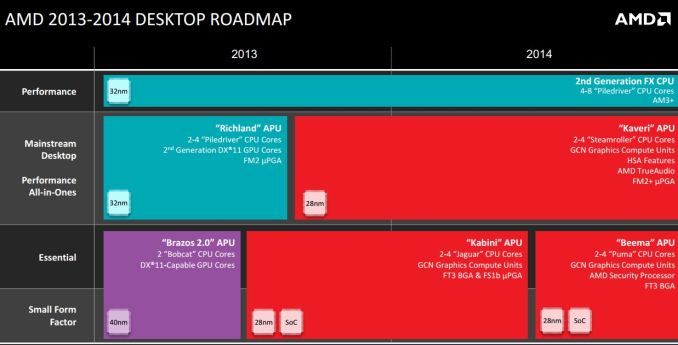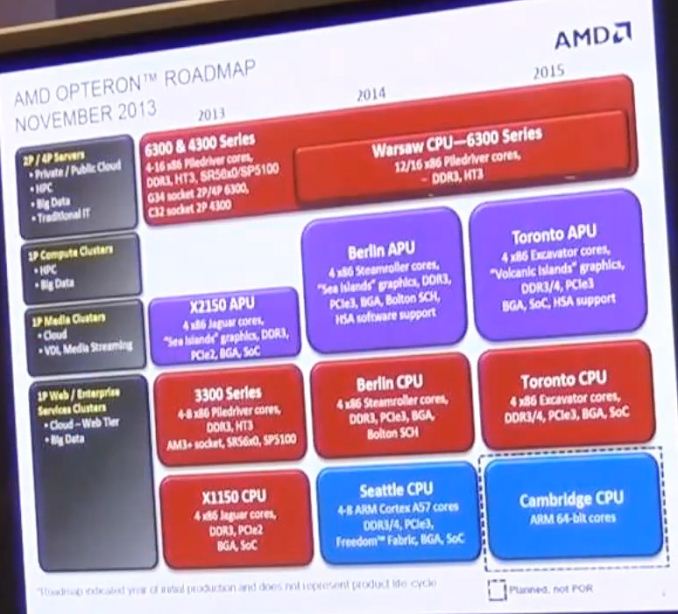AMD Kaveri Review: A8-7600 and A10-7850K Tested
by Ian Cutress & Rahul Garg on January 14, 2014 8:00 AM ESTSocket: FM2+
The new Kaveri processors are built to use the sort-of new FM2+ socket based motherboards. These motherboards fit both FM2+ and FM2 APUs, and thus have been on the market for a good number of months already. However the boards currently on the market may require a BIOS update, and e-tailers shipping motherboards out today may still have the older not-updated revisions in stock, so it is worth confirming that the motherboard you order is updated.
AMD’s generational split on Kaveri is indicative of market pressure and AMD’s history – users like either the processor or the motherboard to be forwards or backwards compatible in terms of compliance. In this case the following table applies:
| Socket Compatibility Chart | ||
| Will Work in FM2 | Will Work in FM2+ | |
| Richland | Yes | Yes |
| Kaveri | No | Yes |
As Kaveri comes with two extra pins that are blocked off with older FM2 motherboards, they are not compatible.
For our testing today, we had sourced the ASRock FM2A88X Extreme6+ and FM2A88X-ITX+ motherboards, both of which will be the focus for review in due course.
Chipset/FCH: A55, A78, A88X
To add some confusion into the mix, AMD is using a mixture of old and new chipsets on FM2+. Kaveri will support the A55, A78 and A88X chipset based motherboards, but not the A75 chipset that was used for Llano/FM1 motherboards. Perhaps more confusing is that while the old Richland APUs will be able to be used on FM2+ with A88X, the older FM2 motherboards will not come with A88X. How about a table to make it clearer:
| Chipset Compatibility Chart | |||
|
Will Work with Llano APUs |
Will Work with Trinity & Richland APUs |
Will Work with Kaveri APUs |
|
| A55 + FM1 | Yes | No | No |
| A55 + FM2 | No | Yes | No |
| A55 + FM2+ | No | Yes | Yes |
| A75 + FM1 | Yes | No | No |
| A75 + FM2 | No | Yes | No |
| A78 + FM2+ | No | Yes | Yes |
| A85X + FM2 | No | Yes | No |
| A88X + FM2+ | No | Yes | Yes |
Though even a table doesn't make the compatibility matrix crystal-clear, it does help to make sense of what users can expect for chipset and sock compatibility. Basically, any A88X motherboard you buy will fit the Kaveri APU. For A78, we are currently under the impression that these will be FM2+ only as well, just do not get confused with older ‘AMD 780L’ Northbridge chipsets that were advertised with A78 in the motherboard name that used the AM3 socket. A55 is almost a free-for-all, with FM1 and FM2 motherboards using it.
As for the differences between the older A85X and A88X chipsets, there are only a few to speak of. Support for PCIe 3.0 is the big one, with any FM2+ and A88X motherboard and Kaveri APU taking full advantage of PCIe 3.0 in all its glory, either as an x16 slot or an x8/x8. A88X still has eight 6 Gbps ports and four USB 3.0 ports native, as well as supporting RAID 0, 1, 5 and 10. The other only upgrade to note is the move to XHCI 1.0.
| Chipset Comparison | |||||
| A55 | A75 | A78 | A85X | A88X | |
| Chipsets |
FM1 FM2 FM2+ |
FM1 FM2 |
FM2+ | FM2 | FM2+ |
| PCIe Generation | 2.0 | 2.0 | 2.0 | 2.0 | 3.0 |
| PCIe Lane Allocation | 1x16 | 1x16 or 2x8 | 1x16 | 1x16 or 2x8 | 1x16 or 2x8 |
| SATA 6/3 Gbps | 0 + 6 | 6 + 0 | 6 + 0 (?) | 8 + 0 | 8 + 0 |
| USB Ports (3/2/1.1) | 0 + 14 + 2 | 4 + 10 + 2 | 4 + 10 + 2 (?) | 4 + 10 + 2 | 4 + 10 + 2 |
| RAID | 0, 1, 10 | 0. 1, 5, 10 | 0. 1, 5, 10 | 0. 1, 5, 10 | 0. 1, 5, 10 |
| TDP | 7.6 W | 7.8 W | 7.8 W ? | 7.8 W | 7.8 W ? |
Unusually for AMD, little information about chipset evolution was provided through the normal channels.
What about FX CPUs, or Server CPUs?
Leaked roadmaps have not been kind to AMD’s FX range. The ‘king’ of the Vishera family of FX CPUs, the quad-module eight-thread FX-9590, looks like it will be the king of the FX line for a little while longer, as shown in this roadmap:
As you might imagine, there is no public comment from AMD about the lack of new FX CPUs with Steamroller cores coming soon.
Depending on which roadmap you look at, AMD’s server offerings are mixed. Some report that During 2014 we will see the launch of “Warsaw” CPUs featuring 12-16 Piledriver cores, and there is no current mention of high-end Steamroller based Opterons at all. The official roadmap from AMD from June shows this, including their ARM server discussion, but a recently leaked roadmap shows that Steamroller will appear in their 1P compute clusters, followed by Excavator in 2015, but Piledriver based 12-16 thread machines will stay at the top of the pile.













380 Comments
View All Comments
nader_21007 - Saturday, January 18, 2014 - link
Can you show me what improvement haswell did over previous gen? TDP going from 77W to 84W, meanwhile performance droped in most cases. Can't you see the charts in this review?Principle - Tuesday, January 14, 2014 - link
Andrew, that depends based on size, budget, etc...and I own an AMD Piledriver CPU and could never tell you when it was supposedly slower, maybe a game takes a couple seconds longer to load, but after that its all the same.And I have used Intel CPUs too, and have hiccups and lag multitasking with them in real life, that never happens on my AMD systems. If you get an i5 and an AMD GPU, that would be great and last with the GPU compute advantage of AMD GPUs and the Mantle potential.
These Kaveri have a lot of value at launch for the entertainment center PCs, or ITX platforms because at 65W or even 45W it delivers a lot of performance in one chip that you can keep cool and quiet in a small package. Also good for all in one PCs built into the monitor. Not for the avid gamer right now, but a little more future proof than an Intel CPU in my opinion.
ImSpartacus - Thursday, January 16, 2014 - link
If you're not gaming, is it really that hard to "future-proof" your CPU?I feel like most low end CPUs will perform "basic" non-gaming tasks for many years to come.
andrewaggb - Tuesday, January 14, 2014 - link
To be clear, I'd get an i5 quad core with a 260x or 270x. I realize they aren't at all in the same price range, but it's good performance per dollar.I was expecting Kavari to have 10% better cpu performance and 25% better gpu performance. This has equal cpu performance and essentially equal gpu performance. It has other improvements, but that's a serious dissappointment on the performance side of things.
I've already got 3 i5 quad cores with a 6870, 7850, and 270x in each and I'm happy with them. Just though Kaveri might be good enough, and it is for older stuff and minecraft and whatnot.
But it seems like yet another year that paying the extra money and having some longevity is going to be the right move.
Quite frankly my oldest system, the i5 750 with a 6870 would mop the floor with kaveri in everything but power consumption.
yankeeDDL - Wednesday, January 15, 2014 - link
You're kidding right?It practically doubled the performance per watt of Richland (45W Kaveri almost always outpaces 100W Richland) and that's disappointing?
It's true that Richland was way behind, but the improvement is massive.
There's still a glaring gap with Intel's CPU, but it is smaller.
Just as much as the glaring gap on the GPU side (but this time on AMD's favor) got wider.
HSA is the key for AMD to push the GPU advantage over to the CPU to compensate. If it works, then Kaveri will be really up to, or better of the core I5 which cost more than 2X ... "IF" ...
Jaybus - Thursday, January 16, 2014 - link
I'm not convinced HSA is the future. It is a diminishing returns issue. The only difference between HSA and SMP is different types of cores are being used. The bus arbitration and coherency issues are exactly the same. Neither is scalable to dozens of cores, let alone hundreds. HSA has the same limitations as SMP. Something like Knights Corner's ring bus and message passing is more likely the future. Near term, there is an advantage to HSA. Long term will rely on a much faster chip-to-chip interconnect to transfers and segmented memory to avoid the arbitration and coherency issues. CMOS silicon photonics maybe. That would enable optical busses orders of magnitude faster than PCIe, or in fact much faster than any chip-to-chip electronic bus, and that would make something like Knights Corner's ring bus the future path to high core counts.jimjamjamie - Thursday, January 16, 2014 - link
A genuinely interesting and insightful comment, thanks.artk2219 - Tuesday, January 14, 2014 - link
Until you play a game that uses more than 2 threads, or have tasks running in the background while gaming, then you'll wish you had those two extra threads. Seriously I wish people would quite trying to recommend dual cores for gaming or even general use, unless its in a machine for the type of person that only does one or two things thing at a time. Dual cores are showing their age now, its only going to be worse a year or two from now. Also why would you spend 90 on a Pentium dual core when you could spend 80 on an Athlon 750k or that same 90 on a 760k. They have similar single thread performance and stomp the g2120 in multithreaded situations, plus they're unlocked so you can overclock to your hearts content. Im not saying that Kaveri isn't overpriced right now, they could stand to drop 20 dollars for the top two chips and 10 for the last chip reviewed. But they just launched and those prices will change, and in the end its easier to point people to one part for all of their needs than it is to point them to two.http://www.newegg.com/Product/ProductList.aspx?Sub...
Nagorak - Wednesday, January 15, 2014 - link
The Intel processors are more energy efficient. That's one reason.artk2219 - Wednesday, January 15, 2014 - link
Fair enough, but its a negligible difference once you factor in the discrete GPU that you would be pairing it with anyways. Cooling it shouldn't be anymore of a problem than cooling the same setup with the DGPU, granted there aren't really any fm2+ itx boards so that may be a problem if you're going for a tiny size, but thats about it.